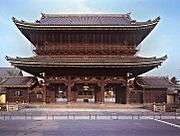Higashi Honganji

Higashi Honganji (東本願寺 Higashi Hongan-ji), or, the Eastern Temple of the Original Vow, is one of two dominant sub-sects of Shin Buddhism in Japan and abroad, the other being Nishi Honganji (or, 'The Western Temple of the Original Vow'). It is also the name of the head temple in Kyoto, a collection of buildings built in 1895 after a fire burned down the previous temple.[1] As with many sites in Kyoto, these two complexes have more casual names and are known affectionately in Kyoto as Onissan (お西さん, Honorable Mr. West) and Ohigashisan (お東さん, Honorable Mr. East).
History
Higashi Honganji was established in 1602 by the Shogun Tokugawa Ieyasu when he split the Shin sect in two (Nishi Honganji being the other) in order to diminish its power.[1]
During the Twentieth Century it was troubled by political disagreements, financial scandals and family disputes, and has subsequently fractured into a number of further sub-divisions (see Ohigashi schism). The largest Higashi Honganji grouping, the Shinshu Otaniha has approximately 5.5 million members, according to statistics.[1] However within this climate of instability the Higashi Honganji also produced a significant number of extremely influential thinkers, such as Soga Ryojin, Kiyozawa Manshi, Kaneko Daiei and Haya Akegarasu amongst others.
See also
| Wikimedia Commons has media related to Higashi Honganji. |
- Glossary of Japanese Buddhism.
- Shōsei-en
References
- 1 2 3 Popular Buddhism In Japan: Shin Buddhist Religion & Culture by Esben Andreasen, pp. 11, 38-39, 101 / University of Hawaii Press 1998, ISBN 0-8248-2028-2
Coordinates: 34°59′28″N 135°45′30″E / 34.991017°N 135.758456°E